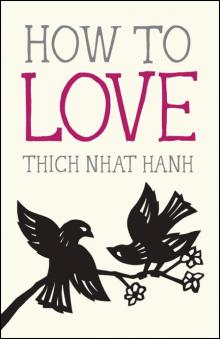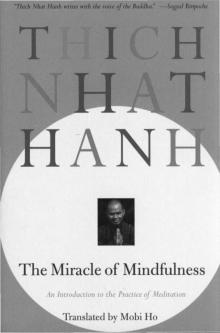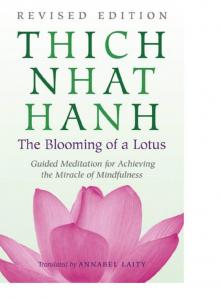- Home
- Thich Nhat Hanh
How to Love Page 4
How to Love Read online
Page 4
LOVE MEDITATION
This love meditation, called Metta Meditation, is adapted from the Visuddimagga (The Path of Purification) by Buddhaghosa, a fifth-century C.E. systematization of the Buddha’s teachings.
May I be peaceful, happy, and light in body and spirit.
May I be safe and free from injury.
May I be free from anger, afflictions, fear, and anxiety.
May I learn to look at myself with the eyes of understanding and love.
May I be able to recognize and touch the seeds of joy and happiness in myself.
May I learn to identify and see the sources of anger, craving, and delusion in myself.
May I know how to nourish the seeds of joy in myself every day.
May I be able to live fresh, solid, and free.
May I be free from attachment and aversion, but not be indifferent.
To begin, sit still and calm your body and your breathing. Sitting still, you aren’t too preoccupied with other matters.
Begin practicing this love meditation on yourself (“May I be peaceful . . .”). Until you are able to love and take care of yourself, you can’t be of much help to others. After that, practice on others (“May he/she/you/they be peaceful . . .”)—first on someone you like, then on someone neutral to you, then on someone you love, and finally on someone the mere thought of whom makes you suffer. After practicing Metta Meditation, you may find you can think of them with genuine compassion.
COMPASSIONATE LISTENING
In the practice of compassionate listening, you listen with only one purpose: to give the other person a chance to speak out and suffer less. Practice breathing in and out deeply and concentrate on what you are hearing. While the other person speaks, they may express bitterness, wrong perceptions, or make accusations. If you allow these things to touch off the anger in you, then you lose your capacity to listen deeply. Listening with mindfulness helps you to keep your compassion alive. It protects you, and your anger will not be triggered. Even fifteen minutes of listening like this can be very healing and can bring a lot of relief to another. You may be the first person who has ever listened to him or her like that.
SELECTIVE WATERING
Selective watering is the process of watering the good seeds and giving the healthy and positive elements in our consciousness a chance to manifest. We can organize our life in such a way that the good seeds can be touched and watered several times a day.
We are the gardeners who identify, water, and cultivate the best seeds in ourselves and in others. We need some faith that there are good seeds within us, and then, with appropriate attention, we need to touch those seeds when we practice sitting meditation, walking meditation, and throughout the day. When we succeed in touching our positive seeds once, we will know how to touch them again and again, and they will strengthen.
HUGGING MEDITATION
When we hug, our hearts connect and we know that we are not separate beings. Hugging with mindfulness and concentration can bring reconciliation, healing, understanding, and much happiness. The practice of mindful hugging has helped so many people to reconcile with each other—fathers and sons, mothers and daughters, friends and friends, and so many others.
You may practice hugging meditation with a friend, your daughter, your father, your partner, or even with a tree. Hugging is a deep practice; you need to be totally present to do it correctly. When I drink a glass of water, I invest one hundred percent of myself in drinking it. You can train yourself to live every moment of your daily life like that.
Before hugging, stand facing each other as you follow your breathing and establish your true presence. Then open your arms and hug your loved one. During the first in-breath and out-breath, become aware that you and your beloved are both alive; with the second in-breath and out-breath, think of where you will both be three hundred years from now; and with the third in-breath and out-breath, be aware of how precious it is that you are both still alive.
When you hug this way, the other person becomes real and alive. You don’t need to wait until one of you is ready to depart for a trip; you may hug right now and receive the warmth and stability of your friend in the present moment. Architects need to build airports and railway stations so that there is enough room to practice hugging. When you hug in this way, your hugging will be deeper, and so will your happiness.
THE FIVE AWARENESSES
These verses can be practiced by anyone at anytime to help safeguard our relationships. Many people have used them in weddings and commitment ceremonies, and some couples like to say them to each other weekly. If you have a bell, you can invite it to sound after you recite each verse. Then breathe in and out a few times in silence before going on to the next verse.
1.We are aware that all generations of our ancestors and all future generations are present in us.
2.We are aware of the expectations that our ancestors, our children, and their children have of us.
3.We are aware that our joy, peace, freedom, and harmony are the joy, peace, freedom, and harmony of our ancestors, our children, and their children.
4.We are aware that understanding is the very foundation of love.
5.We are aware that blaming and arguing can never help us and only create a wider gap between us; that only understanding, trust, and love can help us change and grow.
Parallax Press
P.O. Box 7355
Berkeley, California 94710
www.parallax.org
Parallax Press is the publishing division of
Unified Buddhist Church, Inc.
© 2014 by Unified Buddhist Church
All rights reserved
Cover and text design by Debbie Berne
Illustrations by Jason DeAntonis
This eBook was created using the first print edition from 2014
eBook ISBN: 978-1-937006-89-1
1 2 3 4 5 / 18 17 16 15 14
Library of Congress Cataloging-in-Publication Data is available upon request
RELATED TITLES
Awakening Joy by James Baraz and Shoshana Alexander
Be Free Where You Are by Thich Nhat Hanh
Being Peace by Thich Nhat Hanh
Breathe, You Are Alive! by Thich Nhat Hanh
Deep Relaxation by Sister Chan Khong
Happiness by Thich Nhat Hanh
How to Sit by Thich Nhat Hanh
Making Space by Thich Nhat Hanh
Moments of Mindfulness by Thich Nhat Hanh
Not Quite Nirvana by Rachel Neumann
Small Bites by Annabelle Zinser
Ten Breaths to Happiness by Glen Schneider
Parallax Press is a nonprofit publisher, founded and inspired by Zen Master Thich Nhat Hanh. We publish books on mindfulness in daily life and are committed to making these teachings accessible to everyone and preserving them for future generations. We do this work to alleviate suffering and contribute to a more just and joyful world.
To learn more about our books, click here
Want to connect with like-minded readers? Check out our book club and our blog for reader’s guides and the latest news from Parallax Press.
Subscribe to our newsletter to receive special deals, news from our authors, and inspiration.
Visit us on Facebook
Follow us on Twitter
Add us on Goodreads
To reach mindful living communities following the tradition of Thich Nhat Hanh please contact:
Plum Village
13 Martineau
33580 Dieulivol, France
www.plumvillage.org
Blue Cliff Monastery
3 Mindfulness Road
Pine Bush, NY 12566
www.bluecliffmonastery.org
Deer Park Monastery
2499 Melru Lane
Escondido, CA 92026
www.deerparkmonastery.org
Magnolia Grove Monastery
123 Towles Rd.
Batesville, MS 38606
www.magnoliagrovemona
stery.org
The Mindfulness Bell, a journal of the art of mindful living in the tradition of Thich Nhat Hanh, is published three times a year by Plum Village.
To subscribe or to see the worldwide directory of Sanghas, visit www.mindfulnessbell.org.

 How to Love
How to Love The Miracle of Mindfulness
The Miracle of Mindfulness The Miracle of Mindfulness (Gift Edition)
The Miracle of Mindfulness (Gift Edition) The Blooming of a Lotus
The Blooming of a Lotus The Novice
The Novice